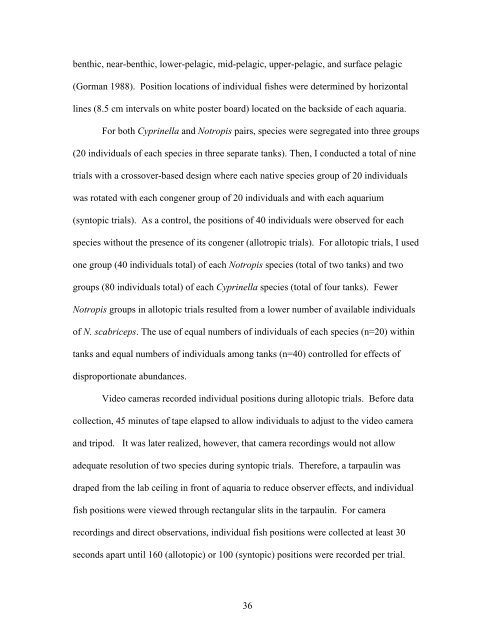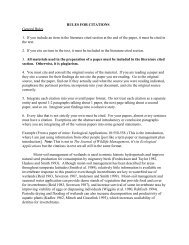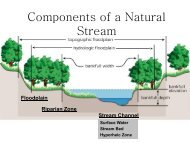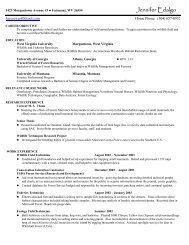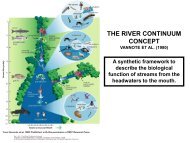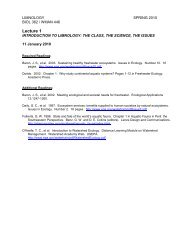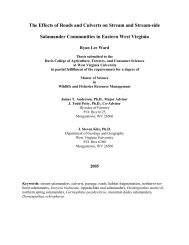An Experimental Study of Vertical Habitat Use and Habitat Shifts in ...
An Experimental Study of Vertical Habitat Use and Habitat Shifts in ...
An Experimental Study of Vertical Habitat Use and Habitat Shifts in ...
Create successful ePaper yourself
Turn your PDF publications into a flip-book with our unique Google optimized e-Paper software.
enthic, near-benthic, lower-pelagic, mid-pelagic, upper-pelagic, <strong>and</strong> surface pelagic<br />
(Gorman 1988). Position locations <strong>of</strong> <strong>in</strong>dividual fishes were determ<strong>in</strong>ed by horizontal<br />
l<strong>in</strong>es (8.5 cm <strong>in</strong>tervals on white poster board) located on the backside <strong>of</strong> each aquaria.<br />
For both Cypr<strong>in</strong>ella <strong>and</strong> Notropis pairs, species were segregated <strong>in</strong>to three groups<br />
(20 <strong>in</strong>dividuals <strong>of</strong> each species <strong>in</strong> three separate tanks). Then, I conducted a total <strong>of</strong> n<strong>in</strong>e<br />
trials with a crossover-based design where each native species group <strong>of</strong> 20 <strong>in</strong>dividuals<br />
was rotated with each congener group <strong>of</strong> 20 <strong>in</strong>dividuals <strong>and</strong> with each aquarium<br />
(syntopic trials). As a control, the positions <strong>of</strong> 40 <strong>in</strong>dividuals were observed for each<br />
species without the presence <strong>of</strong> its congener (allotropic trials). For allotopic trials, I used<br />
one group (40 <strong>in</strong>dividuals total) <strong>of</strong> each Notropis species (total <strong>of</strong> two tanks) <strong>and</strong> two<br />
groups (80 <strong>in</strong>dividuals total) <strong>of</strong> each Cypr<strong>in</strong>ella species (total <strong>of</strong> four tanks). Fewer<br />
Notropis groups <strong>in</strong> allotopic trials resulted from a lower number <strong>of</strong> available <strong>in</strong>dividuals<br />
<strong>of</strong> N. scabriceps. The use <strong>of</strong> equal numbers <strong>of</strong> <strong>in</strong>dividuals <strong>of</strong> each species (n=20) with<strong>in</strong><br />
tanks <strong>and</strong> equal numbers <strong>of</strong> <strong>in</strong>dividuals among tanks (n=40) controlled for effects <strong>of</strong><br />
disproportionate abundances.<br />
Video cameras recorded <strong>in</strong>dividual positions dur<strong>in</strong>g allotopic trials. Before data<br />
collection, 45 m<strong>in</strong>utes <strong>of</strong> tape elapsed to allow <strong>in</strong>dividuals to adjust to the video camera<br />
<strong>and</strong> tripod. It was later realized, however, that camera record<strong>in</strong>gs would not allow<br />
adequate resolution <strong>of</strong> two species dur<strong>in</strong>g syntopic trials. Therefore, a tarpaul<strong>in</strong> was<br />
draped from the lab ceil<strong>in</strong>g <strong>in</strong> front <strong>of</strong> aquaria to reduce observer effects, <strong>and</strong> <strong>in</strong>dividual<br />
fish positions were viewed through rectangular slits <strong>in</strong> the tarpaul<strong>in</strong>. For camera<br />
record<strong>in</strong>gs <strong>and</strong> direct observations, <strong>in</strong>dividual fish positions were collected at least 30<br />
seconds apart until 160 (allotopic) or 100 (syntopic) positions were recorded per trial.<br />
36


